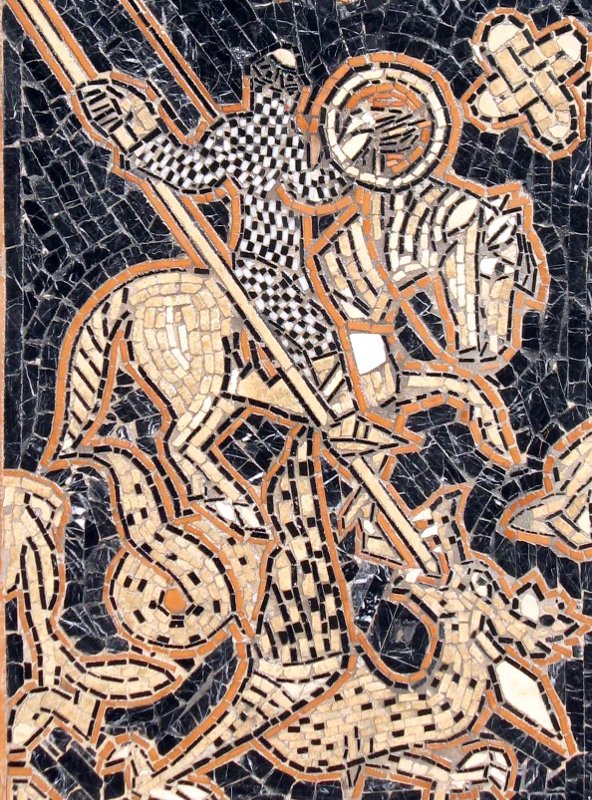Artist Frederic Lecut
Creating Communion
By Amanda Smith • Photography by Brian W. McDonald
Mosaics date back to ancient times, the Greeks elevating their creation to an art form. Tiny stones in different hues merge to construct elaborate works. By themselves, the bits of stone are unremarkable, yet when interwoven into complex patterns and pictures, the end result is a masterpiece. This is not unlike the events in a human life. Taken in and of itself, each experience can seem mundane and ordinary, but combine them, and the adult who emerges can be a complex being able to accomplish remarkable things. Such is the case with Frederic Lecut.
Lecut, who currently lives in Headland, Alabama, was born and raised in the Picardy region of northern France—a treasure trove of old-fashioned towns and quiet resorts, known for its great cathedrals, abbeys and medieval might. As a child, Lecut enjoyed archaeology and visiting historical sites in and near his hometown, many of which were decorated by mosaics. His parents traveled with him in tow, showing him landmarks such as Roman ruins in which gorgeous mosaics cover the floors and walls of the ancient elite. Thus, a seed was planted.
Time moved on, and as a young man, Lecut struggled with depression. "I know what this is," he says. "You are in a deep, black hole with no interest in anything. Things you enjoyed before— fishing, boating—have no interest to you now." During this period, Lecut had a job teaching martial arts in the local village. He would force himself to get out of bed in order to lead his classes. Once there, he discovered something: after having immersed himself in teaching, his depression would dissipate. He believes the combination of concentration and inward meditation the discipline requires was partly responsible. Another important element was that, in teaching, he felt he was giving himself to his students. You cannot be unhappy when you help others, Lecut says.

This act of giving awoke within him a passion for martial arts which has never dimmed. Today, he teaches a variety of martial arts classes and writes about the subject at www.underthemoonshadow. blogspot.com. His background in this ancient discipline laid another piece into the mosaic of his life. It honed an ability to focus for long periods of time, a skill he would later use when formulating works of art.
Lecut studied nuclear and mechanical engineering, which eventually led to an international career that brought him to South Alabama in the 1980s. Lecut's background in engineering fostered a love for building and creating things, and it appealed to his meticulous nature.
Though his work allowed him to live well and support his children, Lecut was aware of a growing unhappiness. His job was stressful, and the pressure was constant. When he developed a stomach ulcer, he knew it was time for a change. His children were grown and on their own. In 2000, he decided to quit his job and pursue his true love, teaching martial arts.
Three years later, during a visit to France, his mother introduced him to Jean Pierre Soalhat, an internationally recognized mosaic artist based in a little Provence village called Caseneuve. Lecut was enthralled. He was immediately reminded of the venerable mosaics he had loved as a child, and another piece of his life's mosaic clicked into place. He apprenticed with Soalhat, then acquired some tools and returned home to Headland, where he began making mosaics of his own.
It's a delicate, detailed and painstaking process. Lecut envisions a design, first seeing a hint of an image in his head. Little by little, it develops into something he can sketch. Once he has it on paper, he enlarges and laminates the blueprint. Then, he begins cutting stones and places them, in reverse, on his pattern. He works in sections, laying stones, securing them and letting them dry. By the time he has finished a medium-size mosaic, he has invested more than 50 hours into the piece.
When working on a mosaic, he often becomes completely absorbed. He'll forget to eat or sleep. "It's a total engagement of mind and body," he remarks. It is the same sense of concentration he feels when doing martial arts. After the completed project has dried for several days, Lecut faces the moment of truth. He carefully flips the design and sees it from the front for the first time. "It's," he struggles for words, then shrugs and smiles, "a magical moment."
The process is a spiritual one for Lecut. He uses tools like those employed thousands of years ago by makers of mosaics, and feels as if he's participating in an ancient ritual that connects him to those artisans. He compares it to entering a cathedral where people have worshiped for centuries. "You cannot but feel awe—there is something sacred there," he says.

This is different from the feeling he has when seeing breathtaking new architecture in locales he's traveled, like Dubai and New York. As a lover of architecture, Lecut is astounded by the structures in these destinations, but it is not the same experience as going to a place, even a simple place, where others have gone for centuries for the same purpose. "All these people who have been here before you, feeling as you feel now—this is what ritual is about. It puts you in communion with other people," he affirms. This extraordinary communion is reflected in Lecut's work. It draws the viewer into that solidarity and provides a glimpse into the past.






































